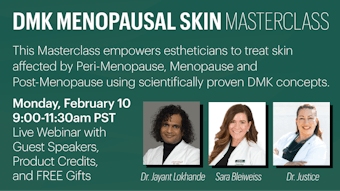
Both topically and internally, the focus on nutrition and skin care is becoming a clear pathway to improved skin wellness.
Whether through supplementation or the encouragement of dietary improvement, avoiding this topic with your clients is doing a disservice to their skin care goals. In this column, you will get the point of view of a physician and esthetician, as well as a marketing perspective on the importance of nutrition when it comes to skin wellness, providing truthful, useful information as to why the healthy way is the right way for your clients.
Physician’s point of view: Steven H. Dayan MD, FACS
There is a movement called age management medicine. Physicians who are proponents of this movement argue that the goal is not to make clients live longer, but to make them live healthier. Traditional medicine teaches that eating a balanced meal will provide the body with all the vitamins and minerals necessary for good health. Some concepts, such as supplementation with oral antioxidants and fish oils, have been thought of as radical. However, antioxidant therapy is known to reduce inflammation and even to reverse some of the damage caused by heart disease.
Commonly, the diet of many Americans is full of simple sugars, carbohydrates and bad fats, which include saturated and trans fats. They are considered bad fats because they elevate cholesterol levels, promote inflammation and can lead to heart disease.
Saturated fats are found in whole milk, cheese, red meats, poultry skin and even in some plant foods, such as palm and coconut oils. Trans fats are man-made fats that are most commonly seen in processed foods. Trans fats were created to allow a liquid fat to turn into a solid and last longer without spoiling. These fats are the worst kinds of fats and are often listed on labels as hydrogenated oils. They are used for frying and also to increase the stability and shelf life of snack foods. Most fried foods and processed meats, chips and margarine contain high levels of these trans fats, which are associated with increasing the levels of bad cholesterol in the blood, leading to heart disease and triggering inflammation. Inflammation may be the main culprit in cancer, aging and poor skin, so it is best to advise clients to eliminate foods that contain hydrogenated oils from their diets.
Good fats include monounsaturated fats, such as those found in olives, olive oil, peanuts and avocados, and polyunsaturated fats, such as those found in corn, soybeans and fish. Fish, in particular, contain high amounts of the polyunsaturated fat omega-3. Omega-3 fats are not made internally in the body and can only be acquired from the diet. Omega-6 fats are also found in nature, are important for healthy metabolic function and are found in soy, sunflower, cottonseed, canola, peanut, grape seed and corn oils. Foods rich in omega-3 and -6 are common to the Mediterranean diet, and may be partly responsible for the low rates of heart disease and cancer seen in people living on Greek islands, such as Crete. Diets too high in omega-6 fats can be a cause of inflammation and are not healthy. Not only do diets with good fats reduce inflammation and heart disease, but they also may improve the appearance of the skin.
The intake of sugar and simple carbohydrates may also affect the skin’s appearance. Foods such as soda, many types of bread, candy bars and beer raise blood sugar levels rapidly. This results in a quick energy boost, but soon follows with a rapid fall in blood sugar levels, resulting in fatigue and hunger. The cycle is vicious. It is not healthy and leads to long-term inflammation and cell injury. It is now known that excess sugar in the body throughout time can negatively affect many organs, including the skin. A diet rich in sugar ultimately affects the aging of skin and can actually make a person look older. Excess sugar is also speculated to affect collagen fibers and results in a process called glycation, which causes the skin to turn yellow and look older.
Esthetician’s point of view: Terri A. Wojak
Skin care professionals often know the benefits of topically adding nutrients to the skin. The detail that many forget is that the skin is an organ—actually the largest organ of the body. Skin care professionals need to learn to treat it from the inside, as well as the outside.
Many studies have shown the health-protecting benefits of antioxidants. Antioxidants are vitamins or nutrients that protect the body from oxidative stress by fighting off free radicals. Free radicals are highly reactive molecules that can cause damage to the body, especially the skin. Perhaps the best known antioxidant is vitamin E, which can help the body fight against heart disease and inflammation, and is an important protector of the skin. By increasing vitamin E levels in the body, the skin may not sustain as much damage and may repair injured cells at a faster rate. Vitamin E is also thought to improve the general appearance of the skin, giving added protection against sun damage and aging skin. However, it takes two-to-three weeks for enough vitamin E to build up in the skin before this added protection actually goes into effect.
Vitamin C is also a potent antioxidant and a necessary contributor to collagen synthesis and wound-healing. A balanced diet is enough to maintain healthy collagen production in the body. Taking additional vitamin C orally does not seem to have much of a direct effect on reversing the appearance of fine lines and wrinkles; however, as a topical serum, vitamin C has shown some impressive results in regard to reducing inflammation and improving the appearance of the skin. The key is that it must be delivered to the skin in exactly the right form. As a topical cream, it has its merits; however, the packaging process common to many retail cosmetic lines too frequently deactivates vitamin C. In the form of L-ascorbic acid, vitamin C is an unstable molecule; therefore, if it is not produced in the correct way or if it is exposed to air, the product oxidizes and becomes less effective. Vitamin C-based products by reputable companies will likely be packaged and formulated in a way that will keep the ingredient stabilized. Other nutritional supplements, such as lycopene, which is found in tomatoes, coenzyme Q10, minerals such as zinc, and botanicals such as green tea all may be beneficial in reducing inflammation. However, clinical trials supporting these claims are lacking. Therefore, it is in the client’s best interest to eat a diet that is rich in antioxidants.
Although studies are still in progress, nutrition will likely become an increasingly important component for preventing and treating disease, and a necessary ingredient for improving the appearance of one’s skin.
Marketing point of view: Tracy L. Drumm
When adding new products or services to your skin care facility, the key is to follow the rule of the three E’s: engage, educate and entice the client. Today’s consumer is bombarded with marketing messages, from flashy advertisements touting the latest and greatest to texts and tweets, so your marketing messages now have constant competition.
Introducing new products, such as nutritional supplements, will require a compelling message with a direct call to action. The secret to engaging your clients is as simple as controlling the number of messages or stimulation they are exposed to while at your skin care facility. Rather than having six new products featured in your reception area or treatment rooms, focus instead on rotating one product at a time. It is a common theory in marketing that if you say too much—or send too many messages—you often say nothing at all. Fight the need to over-promote and instead engage your clients by eliminating the “communi-clutter” in your facility. When possible, incorporate interactive promotions, such as samples for clients to touch, try and smell.
Whether you are offering a new moisturizer or introducing a new line of supplements, clients do not want to be sold to. Instead, they want to be educated about how the new products will enhance their lives. Begin any promotion or marketing initiative by asking yourself how you can position the product as an educational experience for your clientele. For example, if you are offering nutritional supplements at your medical spa for use after treatments, you can educate clients about how the supplements will help minimize swelling and bruising after an injection.
A simple, yet effective marketing tool being used by many spas and medical spas is the scratch-off trivia card that can be customized to your facility’s brand and to the products or supplements you are introducing. This tool doubles its effectiveness because it engages the clients through the scratch-off promotion and educates them through the trivia on the cards.
The third component to the law of the E’s is to ensure your offer or educational materials are enticing. They should not only engage the client and educate them, but your materials need to have a call to action or a sense of urgency to help guide the client to inquire about the new supplements. By adding an attractive offer or promoting the alluring benefits and results of the supplements, you will help ensure your client has the best possible experience with you and your business.
Today, many skin care facilities are working harder than ever to keep their clients’ attention. By adhering to three Es, your supplements can quickly become a welcomed addition to your clients’ daily regimens and another reason to keep your business at the top of their priority list.
Steven H. Dayan, MD, FACS, is a recognized expert in the field of facial plastic surgery and is a member of the American Academy of Facial Plastic and Reconstructive Surgery. His passion for education led him to open True University in Chicago, a training center that teaches estheticians how to appropriately work with physicians. Dayan is a 2010–2011 member of the Skin Inc. magazine editorial advisory board.
Terri A. Wojak is a licensed esthetician with more than 14 years of experience. She has knowledge in all aspects of the skin care industry, including education, sales, medical esthetics, management and ownership, and she is the director, as well as an educator, at True University in Chicago.
Tracy L. Drumm manages the day-to-day operations of IF Marketing, a Chicago firm specializing in aesthetic medicine. Drumm recently co-authored Keys to Success: Marketing & Practice Management (College of Cosmetic Medicine Press, 2007) and Thrive: Pearls to Prosper in Any Economy (College of Cosmetic Medicine Press, 2009).










